
A brass instrument is a musical instrument that produces sound by sympathetic vibration of air in a tubular resonator in sympathy with the vibration of the player's lips. Brass instruments are also called labrosones or labrophones, from Latin and Greek elements meaning 'lip' and 'sound'.

The euphonium is a medium-sized, 3 or 4-valve, often compensating, conical-bore, tenor-voiced brass instrument that derives its name from the Ancient Greek word εὔφωνος euphōnos, meaning "well-sounding" or "sweet-voiced". The euphonium is a valved instrument. Nearly all current models have piston valves, though some models with rotary valves do exist.

A musical ensemble, also known as a music group or musical group, is a group of people who perform instrumental or vocal music, with the ensemble typically known by a distinct name. Some music ensembles consist solely of instruments, such as the jazz quartet or the orchestra. Some music ensembles consist solely of singers, such as choirs and doo wop groups. In both popular music and classical music, there are ensembles in which both instrumentalists and singers perform, such as the rock band or the Baroque chamber group for basso continuo and one or more singers. In classical music, trios or quartets either blend the sounds of musical instrument families or group together instruments from the same instrument family, such as string ensembles or wind ensembles. Some ensembles blend the sounds of a variety of instrument families, such as the orchestra, which uses a string section, brass instruments, woodwinds and percussion instruments, or the concert band, which uses brass, woodwinds and percussion.
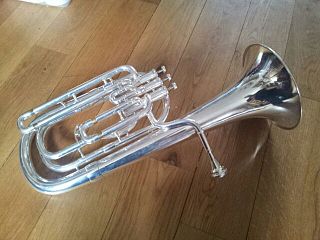
The baritone horn, or sometimes just called baritone, is a low-pitched brass instrument in the saxhorn family. It is a piston-valve brass instrument with a bore that is mostly conical but it has a narrower bore than the similarly pitched euphonium. It uses a wide-rimmed cup mouthpiece like that of its peers, the trombone and euphonium. Like the trombone and the euphonium, the baritone horn can be considered either a transposing or non-transposing instrument.
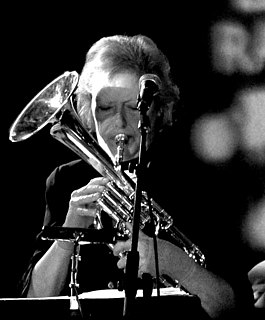
The tenor horn is a brass instrument in the saxhorn family, and is usually pitched in E♭. It has a bore that is mostly conical, like the flugelhorn and baritone horn, and normally uses a deep, cornet-like mouthpiece.

A concert band, variously also called a wind ensemble, symphonic band, wind symphony, wind orchestra, wind band, symphonic winds, symphony band, or symphonic wind ensemble, is a performing ensemble consisting of members of the woodwind, brass, and percussion families of instruments, and occasionally including the double bass or bass guitar. On rare occasions, additional non-traditional instruments may be added to such ensembles such as piano, harp, synthesizer, or electric guitar.

A brass quintet is a five-piece musical ensemble composed of brass instruments. As a common ensemble group, the brass quintet has a broad repertoire containing musical genres from madrigals to jazz.
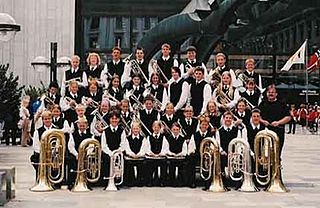
A school band is a group of student musicians who rehearse and perform instrumental music together. A concert band is usually under the direction of one or more conductors. A school band consists of woodwind instruments, brass instruments and percussion instruments, although upper level bands may also have string basses or bass guitar.
English Folk Song Suite is one of English composer Ralph Vaughan Williams' most famous works. It was first published for the military band as Folk Song Suite and its premiere was given at Kneller Hall on 4 July 1923, conducted by Lt Hector Adkins. The piece was then arranged for full orchestra in 1924 by Vaughan Williams' student Gordon Jacob and published as English Folk Song Suite. The piece was later arranged for British-style brass band in 1956 by Frank Wright and published as English Folk Songs Suite. All three versions were published by Boosey & Hawkes; note the use of three different titles for the three different versions.

Marching brass instruments are brass instruments specially designed to be played while moving. Most instruments do not have a marching version - only the following have marching versions:

A brass band is a musical ensemble generally consisting entirely of brass instruments, most often with a percussion section. Ensembles that include brass and woodwind instruments can in certain traditions also be termed brass bands, but may more correctly termed military bands, concert bands, or "brass and reed" bands.
The First Suite in E♭ for Military Band, Op. 28, No. 1, by the British composer Gustav Holst is considered one of the cornerstone masterworks in the concert band repertoire. Officially premiered in 1920 at the Royal Military School of Music, the manuscript was originally completed in 1909. Along with the subsequent Second Suite in F for Military Band, written in 1911 and premiered in 1922, the First Suite convinced many other prominent composers that serious music could be written specifically for band.

Miles & Quincy: Live at Montreux is a collaborative live album by American jazz trumpeter Miles Davis and conductor Quincy Jones. It was recorded at the 1991 Montreux Jazz Festival and released by Warner Bros. Records in 1993.

The euphonium repertoire consists of solo literature and parts in band or, less commonly, orchestral music written for the euphonium. Since its invention in 1843, the euphonium has always had an important role in ensembles, but solo literature was slow to appear, consisting of only a handful of lighter solos until the 1960s. Since then, however, the breadth and depth of the solo euphonium repertoire has increased dramatically.
The Georgia Brass Band was conceived by co-founders Joe Johnson and Christopher Priest in the spring of 1999. It is a traditional British brass band. The band performed its first concert in September of that year and has maintained a very busy schedule ever since. Band members are selected by audition or invitation and include some of the finest musicians in the Atlanta area.
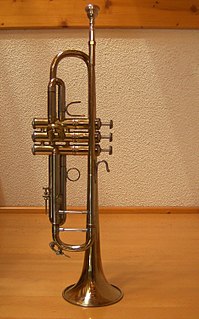
The trumpet repertoire consists of solo literature and orchestral or, more commonly, band parts written for the trumpet. Tracings its origins to 1500 BC, the trumpet is a musical instrument with the highest register in the brass family.

A fanfare band, fanfare corps, fanfare battery, fanfare team, horn and drum corps, bugle band, drum and bugle corps, or trumpet and drum band is a military or civilian musical ensemble composed of percussion instruments, bugles, natural horns and natural trumpets. Fanfare bands are the descendants of the old medieval trumpet and drum teams that sounded fanfares on important occasions and are related to drum and bugle corps internationally.
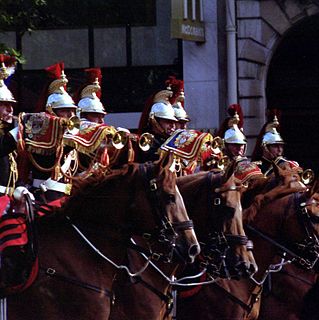
A Fanfare Orchestra is a type of brass band consisting of the entire saxophone family, trumpets, trombones, euphoniums, baritone horns, flugelhorns and alto/tenor- or F-horns, as well as percussion. They are seldom seen outside of Europe, with a high concentration of these bands in Belgium and the Netherlands, many of them civil bands with a few Dutch bands also serving the Armed forces of the Netherlands and its veterans.

A Charanga is a small amateur marching band with wind and percussion instruments that plays festivals mainly in Northern Spain and the Valencian Community. In the past, the name charanga also applied to certain military musical bands of the Spanish Army and as ship's company bands in the Spanish Navy.
Peter Meechan is a British composer, conductor, and music publisher.
















